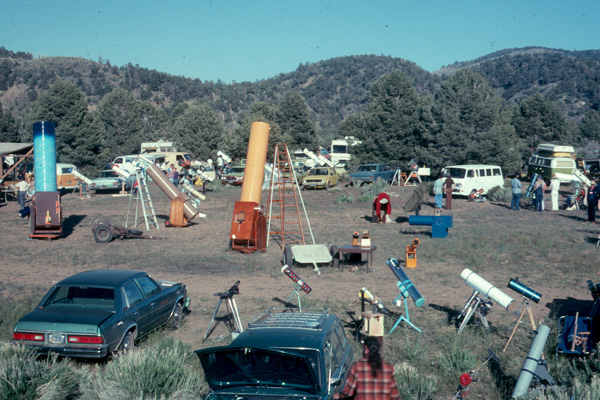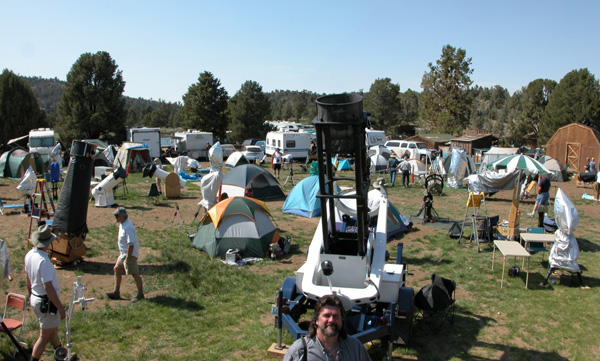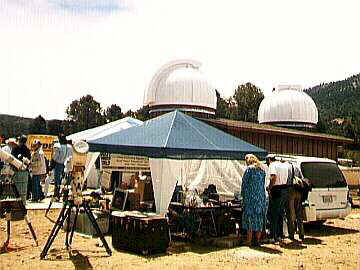Well-loved Astronomy Expo Comes to an End – Sky & Telescope
The RTMC Astronomy Expo, a favorite yearly convo of amateur astronomers and telescope makers, is ending. The author takes a look back at the meeting’s glory days.

Robert Stephens / RTMC
After 50 years, the Riverside Telescope Maker’s Conference (RTMC) has ended its famous annual Astronomy Expo.
Many factors contributed to the board’s decision on October 6th to close off what was still one of the largest star parties and convocations on the West Coast. But even as it averaged 400 to 500 attendees (600 at its recent 50th anniversary), the event could no longer compete with its reputation. And, like a veteran Hall of Famer, the board called it off before it lost its glory.

A scene of the 1978 RTMCRobert Stephens / RTMC
The glory was in the hundreds of Merit Awards that went to so many participants, who worked through the years to produce telescope masterpieces. They would haul their scopes to Big Bear to show them off, showcasing their machine work, mirror polishing, and carved telescope tubes.

Participants at the 1979 RTMC await the announcements of the Merit Awards.Robert Stephens / RTMC
The glory was also in camping with once-a-year buddies, year after year, and in eating in the mess hall with people from all over, where we all wondered whether the wind (or snow) would come up, or just another wonderful night of observing.
The glory was in the feeding frenzy at the swap meet on Saturday morning, with people buzzing around all the equipment that was waiting for its next observer.
The glory was in seeing Donald Machholz’s comets — especially the one that he discovered at RTMC — and in listening to astronomy celebrities Alan Hale and Thomas Bopp talk about their comet (the first time I saw it, I was with them on that telescope field), or to Clyde Tombaugh telling about Pluto, or to Harrison Schmitt chatting about the rocks he’d found on the Moon.
The glory was in the hundreds of people stuck outside the main meeting hall. There were simply too many to fit, so the extra attendees would set up their support group “Out Front” and demanded (loudly) “Stir The Pot!” whenever they felt that too many of the door prize tickets were going “Inside” or “Out back.” (If you’ve ever been there, you know what all that silliness was about!)
Then there was ziplining over canoes in the lake, or hitting the climbing walls, or the pool. It was a YMCA camp and there was so much to do.
For the many volunteers who kept the program going, the glory was in doing something important for the hobby and their fellow astronomers.
Many astronomers on the West Coast have their own favorite memories from RTMC. For me, one was when Al Nagler looked through the first scope I made. That was exciting enough, but then, as he walked away, he said, “Nice.” That made it glorious.

This scene from a more recent RTMC shows the same dedication to community and really cool scopes.
Robert Stephens / RTMC
It all began in 1969, when Cliff Holmes, then president of the Riverside Astronomical Society, got together with his telescope-making buddies for a conference at Riverside Community College. For awhile, the event was called “Riverside,” and it pulled in some 135 attendants. But within a few years it outgrew the college. The conference moved to the mountains, and then finally to Camp Oakes in Big Bear to accommodate all of the telescopes, people, and observing.
In the conference’s heyday in 1987, 2,340 people came to see the show. The event even outgrew the Riverside Club that founded it and became its own corporation in the early nineties. When Imaging, Observing, and Beginner’s Corner became a big part of what it did, the board renamed the evet the RTMC Astronomy Expo.

A scene from the 1997 expo.Robert Stephens / RTMC
Southern California, home to many observers and imagers, was also home to Celestron, Meade, and other forces in the hobby. This cauldron of innovation kept RTMC-AE ahead of other star parties. It was the first event to have industry people (in its second year, Thomas Cave made a presentation), and then vendors (when Celestron brought a tentful of goodies in 1979). At its peak, there were more than 60 vendor tents crowding out the telescopes on the field. The first digital setting circles made their debut at RTMC in 1978. And while John Dobson may have begun his sidewalk astronomy movement on the streets of San Francisco, it wasn’t until he brought those hippie-flowered tubes to RTMC that many others jumped on board.
The real strength of the RTMC-AE was that the program that included three indoor venues with presentations, workshops, and — importantly — a Beginner’s Corner. With outdoor telescope projects spread across the campground and vendor tents in several areas, one could get an education about the latest and greatest equipment just by walking around outside and asking, “What’s that?”
We can speculate about what eroded the conference’s attendance — people do. Regardless, once it became clear that it would not return to its glory days, the RTMC Board made the difficult decision to retire the event.
Other star parties will try to take its place: Nightfall, Golden State Star Party, Julian Star Fest, and others have sprouted through the years to meet our needs on the West Coast. But there will not be any more glory for RTMC.





